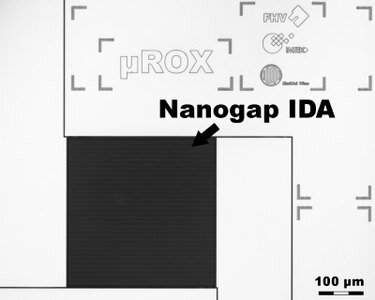µROX - µRNA Redox cycling
The goal of this innovative project of the research centre microtechnology at de FHV - Vorarlberg University of Applied Sciences was to develop a fast, cost-effective and ultrasensitive electrochemical lab-on-a-chip (LOC) platform that can simultaneously detect different microRNAs (µRNAs) without sample preparation.
The project passed through three main major groups: The fabrication of the microchip, the discovery of potential biomarkers (µRNAs) for tumor classification, and the development of a highly sensitive as well as selective detection method.

Project goals
The microchip, which features nanometer-scale finger-like structures, will be fabricated using semiconductor manufacturing technologies. These finger-like structures serve as electrodes for electrochemical measurement. Different materials (Pt, Au, Carbon) were used as electrodes and the electrochemical behavior was studied. A special electrochemical method, in which certain substances are oxidized and reduced again, was used (redox cycling). These substances behave differently depending on the electrode material.
The advantage is that this can provide signal amplification compared to the oxidized-only or reduced-only sensors. The smaller the distance between the electrodes, the higher the signal amplification. Our experiments have shown that this amplification depends very much on the electrode material used as well as on the substance. The largest constant signal amplification window was obtained with gold, with a signal amplification of 161, where the electrode spacing was 100 nm and the redox substance used was ferrocenemethanol (FcMeOH). Carbon as the electrode material, on the other hand, exhibits a non-constant amplification window, which limits the range of application. Different combinations of redox substances and electrode materials were investigated to obtain maximum signal amplification. Not only the signal amplification is in the foreground, but also the stability as well as the possible measuring range.
In addition, potential biomarkers, in total 50, highly aggressive brain tumors (medulloblastomas and ETMR) of young children, were investigated and analyzed with a "high troughphut" method more than 870 tumor associated µRNAs per sample. For both tumor identities, one specifically up-regulated µRNA cluster was identified and subsequently also found to be elevated in the serum samples of the patients. Furthermore, the detected levels could also be correlated with tumor progression. The more aggressive and resistant a tumor was, the higher the corresponding µRNAs were detectable in the serum of the patients.
In order to detect the µRNAs, a fluidics handling system is needed that can specifically detect the µRNAs. This fluidics system (LOC) must also include a method that is very sensitive, as well as very selective, in detecting the specific µRNA. In this regard, a novel electrochemical system based on CRISPR/Cas13a was developed in this project. This makes it possible to very selectively detect the desired µRNAs.
The project was supported by the Austrian Science Fund (Austrian Science Fond FWF: I3419).
Further information
Publications:
- V. Matylitskaya, S. Kasemann, G. Urban, C. Dincer, S. Partel, "Electrochemical characterization of nanogap interdigitated electrode arrays for lab-on-a-chip applications," J. Electrochem. Soc., 2018,165(3), B127 - B134.
- Senfter D, Samadaei M, Mader RM, Gojo J, Peyrl A, Krupitza G, Kool M, Sill M, Haberler C, Ricken G, Czech T, Slavc I and Madlener S*. High impact of miRNA-4521 on FOXM1 expression in medulloblastoma. Accepted Manuscript in Cell death and Disease, 2019 Aug. doi:10.1038/s41419-019-1926-1
- Bruch R, Baaske J, Chatelle C, Meirich M, Madlener S, Weber W, Dincer C and Urban G.CRISPR/Cas13a powered electrochemical microfluidic biosensor for nucleic acid amplification-free miRNA diagnostics. Accepted in Advanced Materials, Sept.2019 DOI: 10.1002/adma.201905311
- Wieland, F.; Bruch, R.; Bergmann, M.; Partel, S.; Urban, G. A.; Dincer, C. Enhanced Protein Immobilization on Polymers-A Plasma Surface Activation Study. Polymers 2020, 12 (1), 104. https://doi.org/10.3390/polym12010104
- Madlener S, Gojo J. Liquid biomarkers for pediatric brain tumors: biological features, advantages and perspectives. J Pers Med. 2020;10(4):254. published 2020 Nov 27. doi:10.3390/jpm10040254
- Bruch, R, Johnston, M, Kling, A, Mattmüller, T, Baaske, J, Partel, S, Madlener, S, Weber, W, Urban, G A & Dincer, C. CRISPR-powered electrochemical microfluidic multiplexed biosensor for target amplification-free miRNA diagnostics. Biosensors and Bioelectronics 177, 112887 (2021).
International Conference Papers:
- May 2019 - poster presentation at the SNO in San Francisco USA "High impact of miRNA-4521 on FOXM1 expression in medulloblastoma".
- December 2018 - oral talk at the CCC CNS Meeting in Vienna Austria "Liquid Biopsy - the search for the needle in a haystack".
- S. Partel, V. Matylitskaya: Fabrication and Characterization of Interdigitated Electrode Arrays with Nano-gaps for Highly Sensitive Electrochemical Applications, Invited talk at AnalytiX-2017, March 22-24, 2017, Fukuoka, Japan
- V. Matylitskaya, S. Partel: Electrochemical characterization of interdigitated electrode arrays with nanogaps for various reversible redox couples, Talk at BioNanoMed 2017, March 20-22, 2017, Krems, Austria
- V. Matylitskaya, S. Partel: Electrochemical characterization of nanogap interdigitated electrode arrays for lab-on-a-chip applications, Invited talk at 232nd ECS Meeting, October 1-5, 2017, Washington, USA
- Kostal, E.; Kasemann, S.; Dincer, C.; Partel, S. Impedimetric Characterization of Interdigitated Electrode Arrays for Biosensor Applications. Proceedings 2018, 2 (13), 899. poster at EUROSENSOR Graz https://doi.org/10.3390/proceedings2130899
- Laubender E., Matylitskaya V., Kostal E., Kasemann S., Urban G. A., Partel S., Dincer C., "Gold Nanogap Interdigitated Arrays for Redox Cycling Amplified Dopamine Detection," 2019 20th International Conference on Solid-State Sensors, Actuators and Microsystems & Eurosensors XXXIII (TRANSDUCERS & EUROSENSORS XXXIII), Berlin, Germany, 2019, pp. 1017-1020.
- Partel S., Matylitskaya V., "Carbon nanogap electrode arrays for electrochemical sensors and biosensors", poster at 45th International Conference on Micro & Nano Engineering, Rhodes, Greece, 2019




